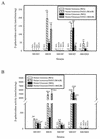Metabolic signals that lead to control of CBB gene expression in Rhodobacter capsulatus
- PMID: 11889097
- PMCID: PMC134932
- DOI: 10.1128/JB.184.7.1905-1915.2002
Metabolic signals that lead to control of CBB gene expression in Rhodobacter capsulatus
Abstract
Various mutant strains were used to examine the regulation and metabolic control of the Calvin-Benson-Bassham (CBB) reductive pentose phosphate pathway in Rhodobacter capsulatus. Previously, a ribulose 1,5-bisphosphate carboxylase/oxygenase (RubisCO)-deficient strain (strain SBI/II) was found to show enhanced levels of cbb(I) and cbb(II) promoter activities during photoheterotrophic growth in the presence of dimethyl sulfoxide. With this strain as the starting point, additional mutations were made in genes encoding phosphoribulokinase and transketolase and in the gene encoding the LysR-type transcriptional activator, CbbR(II). These strains revealed that a product generated by phosphoribulokinase was involved in control of CbbR-mediated cbb gene expression in SBI/II. Additionally, heterologous expression experiments indicated that Rhodobacter sphaeroides CbbR responded to the same metabolic signal in R. capsulatus SBI/II and mutant strain backgrounds.
Figures




Similar articles
-
Effector-mediated interaction of CbbRI and CbbRII regulators with target sequences in Rhodobacter capsulatus.J Bacteriol. 2004 Dec;186(23):8026-35. doi: 10.1128/JB.186.23.8026-8035.2004. J Bacteriol. 2004. PMID: 15547275 Free PMC article.
-
Physiological control and regulation of the Rhodobacter capsulatus cbb operons.J Bacteriol. 1998 Aug;180(16):4258-69. doi: 10.1128/JB.180.16.4258-4269.1998. J Bacteriol. 1998. PMID: 9696777 Free PMC article.
-
Multiple regulators and their interactions in vivo and in vitro with the cbb regulons of Rhodobacter capsulatus.J Mol Biol. 2000 Jul 28;300(5):1079-99. doi: 10.1006/jmbi.2000.3914. J Mol Biol. 2000. PMID: 10903856
-
Genetics and control of CO(2) assimilation in the chemoautotroph Ralstonia eutropha.Arch Microbiol. 2002 Aug;178(2):85-93. doi: 10.1007/s00203-002-0441-3. Epub 2002 Jun 14. Arch Microbiol. 2002. PMID: 12115053 Review.
-
CbbR, the Master Regulator for Microbial Carbon Dioxide Fixation.J Bacteriol. 2015 Nov;197(22):3488-98. doi: 10.1128/JB.00442-15. Epub 2015 Aug 31. J Bacteriol. 2015. PMID: 26324454 Free PMC article. Review.
Cited by
-
The effect of CbbR-binding affinity to the upstream of cbbF and cfxB on the metabolic effector in Rhodobacter sphaeroides.Curr Microbiol. 2015 Jun;70(6):816-20. doi: 10.1007/s00284-015-0789-7. Epub 2015 Feb 24. Curr Microbiol. 2015. PMID: 25708583
-
A Rhodococcus qsdA-encoded enzyme defines a novel class of large-spectrum quorum-quenching lactonases.Appl Environ Microbiol. 2008 Mar;74(5):1357-66. doi: 10.1128/AEM.02014-07. Epub 2008 Jan 11. Appl Environ Microbiol. 2008. PMID: 18192419 Free PMC article.
-
Main components of free organic carbon generated by obligate chemoautotrophic bacteria that inhibit their CO2 fixation.iScience. 2022 Nov 11;25(12):105553. doi: 10.1016/j.isci.2022.105553. eCollection 2022 Dec 22. iScience. 2022. PMID: 36465113 Free PMC article.
-
Amino acid residues of RegA important for interactions with the CbbR-DNA complex of Rhodobacter sphaeroides.J Bacteriol. 2014 Sep;196(17):3179-90. doi: 10.1128/JB.01842-14. Epub 2014 Jun 23. J Bacteriol. 2014. PMID: 24957624 Free PMC article.
-
Effector-mediated interaction of CbbRI and CbbRII regulators with target sequences in Rhodobacter capsulatus.J Bacteriol. 2004 Dec;186(23):8026-35. doi: 10.1128/JB.186.23.8026-8035.2004. J Bacteriol. 2004. PMID: 15547275 Free PMC article.
References
-
- Ausubel, F. M., R. Brent, R. E. Kingston, D. D. Moore, J. G. Seidman, J. A. Smith, and K. Struhl (ed.). 1987. Current protocols in molecular biology. Greene Publishing Associates and Wiley Interscience, New York, N.Y.
-
- Barber, R. D., and T. J. Donohue. 1998. Pathways for transcriptional activation of a glutathione-dependent formaldehyde dehydrogenase gene. J. Mol. Biol. 280:775-784. - PubMed
-
- Bauer, C. E., and T. H. Bird. 1996. Regulatory circuits controlling photosynthesis gene expression. Cell 85:5-8. - PubMed
-
- Chen, J. H., J. L. Gibson, L. A. McCue, and F. R. Tabita. 1991. Identification, expression, and deduced primary structure of transketolase and other enzymes encoded within the form II CO2 fixation operon of Rhodobacter sphaeroides. J. Biol. Chem. 30:20447-20452. - PubMed
Publication types
MeSH terms
Substances
Grants and funding
LinkOut - more resources
Full Text Sources
Other Literature Sources

